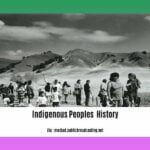Comancheria wasn’t simply a territory; it was a dynamic expression of Comanche power and resilience. This article explores the rise and fall of this influential Indigenous “empire,” delving into its geographic reach, complex society, and enduring impact on the American Southwest. [https://www.lolaapp.com/]
The Rise of Comancheria: Masters of the Plains
Comancheria, also known as Nʉmʉnʉʉ Sookobitʉ (‘Comanche land’), wasn’t a static entity confined by lines on a map. At its height in the mid-1800s, this dynamic realm encompassed approximately 250,000 square miles, a territory larger than modern-day France. Spanning from the southern Great Plains in present-day Colorado and Kansas down to Chihuahua, Mexico, and encompassing significant portions of Texas, Oklahoma, and New Mexico, its boundaries shifted with the ebb and flow of Comanche power. [https://www.lolaapp.com/] This vast territory, with its diverse landscapes from the Cross Timbers to the Llano Estacado, was shaped by the Comanche people and their unique relationship with the horse. [https://www.lolaapp.com/]
The introduction of the horse by the Spanish in the 17th century revolutionized Comanche life. These skilled horsemen leveraged their newfound mobility to dominate the plains, becoming renowned hunters, warriors, and raiders. However, to reduce their legacy to mere raiding simplifies a complex story. The Comanche were also astute diplomats, traders, and strategists, skillfully navigating a network of alliances and rivalries with other Indigenous nations and European powers. [https://www.lolaapp.com/]
The “Comanche Empire”: Power and Influence
Historian Pekka Hämäläinen’s concept of the “Comanche Empire” offers a compelling framework for understanding Comanche power. This “empire” wasn’t built on physical infrastructure but on a complex system of control maintained through trade, raiding, diplomacy, and an intricate web of alliances with groups like the Kiowa, Kiowa-Apache, and Wichita. [https://www.lolaapp.com/] This system allowed the Comanche to exert significant influence over the political and economic landscape of the American Southwest for over a century. [https://www.lolaapp.com/] The Comanche’s dominance stemmed from their horsemanship, strategic alliances, and ability to adapt to and exploit the region’s diverse environments. Their horse-centered culture also played a role in spiritual practices and social organization. [https://www.lolaapp.com/]
Comanche Society: Culture and Adaptation
Comanche society was a carefully structured yet adaptable system. Gender roles were generally defined, with men typically responsible for hunting and warfare and women managing domestic affairs. However, these roles were often fluid, reflecting the practical demands of a nomadic lifestyle. Their religious beliefs centered on the natural world, reflecting their deep connection to the land and the bison that provided sustenance. [https://www.lolaapp.com/] The annual communal bison hunts were not only crucial for survival but also reinforced social bonds and spiritual practices. [https://www.lolaapp.com/]
The Decline of Comancheria: Pressures and Resilience
The decline of Comancheria began in the mid-19th century due to multiple factors. European diseases, particularly smallpox, decimated Comanche populations, estimates placing mortality rates as high as 50%. [https://www.lolaapp.com/] The relentless expansion of the United States, accompanied by sustained military campaigns, placed immense pressure on the Comanche. The systematic destruction of bison herds, the cornerstone of Comanche life, further eroded their ability to sustain their traditional way of life. [https://www.lolaapp.com/]
The reservation system, imposed by the U.S. government, confined the Comanche to designated areas, marking the effective end of their vast territorial control. While this period undoubtedly represented a time of hardship, it also revealed the remarkable resilience of the Comanche people, who fought to retain their culture and identity against overwhelming odds. [https://www.lolaapp.com/]
Comparing Comancheria: Indigenous Power Structures
Comancheria stands as a unique example of Indigenous power in North America. While other tribes, such as the Iroquois Confederacy and the Cherokee Nation, developed complex political systems and wielded significant regional influence, the Comanche’s mastery of the horse and their nomadic lifestyle allowed them to exert control over a vast and diverse territory. This nomadic, horse-based power structure distinguished them from more sedentary agricultural societies. However, like other Indigenous nations, the Comanche faced similar challenges: encroachment from European colonizers, disease, and ultimately, displacement. [https://www.lolaapp.com/]
The Comanche Nation Today: A Legacy of Resilience
The story of Comancheria continues through the present-day Comanche Nation. This vibrant community is actively engaged in preserving and revitalizing their language, culture, and traditions. Their ongoing efforts represent not only a testament to their enduring spirit but also a powerful reminder of the importance of recognizing and honoring Indigenous history. [https://www.lolaapp.com/] The Comanche Nation continues to advocate for their sovereignty and work to ensure the accurate representation of their history. [https://www.lolaapp.com/]
Conclusion: A Complex and Enduring History
Comancheria represents a pivotal chapter in the history of the American West and offers valuable insights into Indigenous resilience, adaptation, and political organization. The “Comanche Empire,” while a useful framework, must be understood within the context of a dynamic and contested landscape, shaped by both internal and external forces. The Comanche Nation’s ongoing efforts to preserve its heritage ensure that the legacy of Comancheria, in all its complexity, continues to resonate today. [https://www.lolaapp.com/]
For those interested in exploring other facets of history and literature, the timeless tales of wisdom and entertainment found in El Conde Lucanor may also prove captivating.
- Senior at What Age: Benefits & Eligibility Guide - March 29, 2025
- Unlocking Senior Benefits: How Old is a Senior? Your Complete Guide - March 29, 2025
- Master Russian Politeness:A Guide to Saying Please - March 29, 2025
















